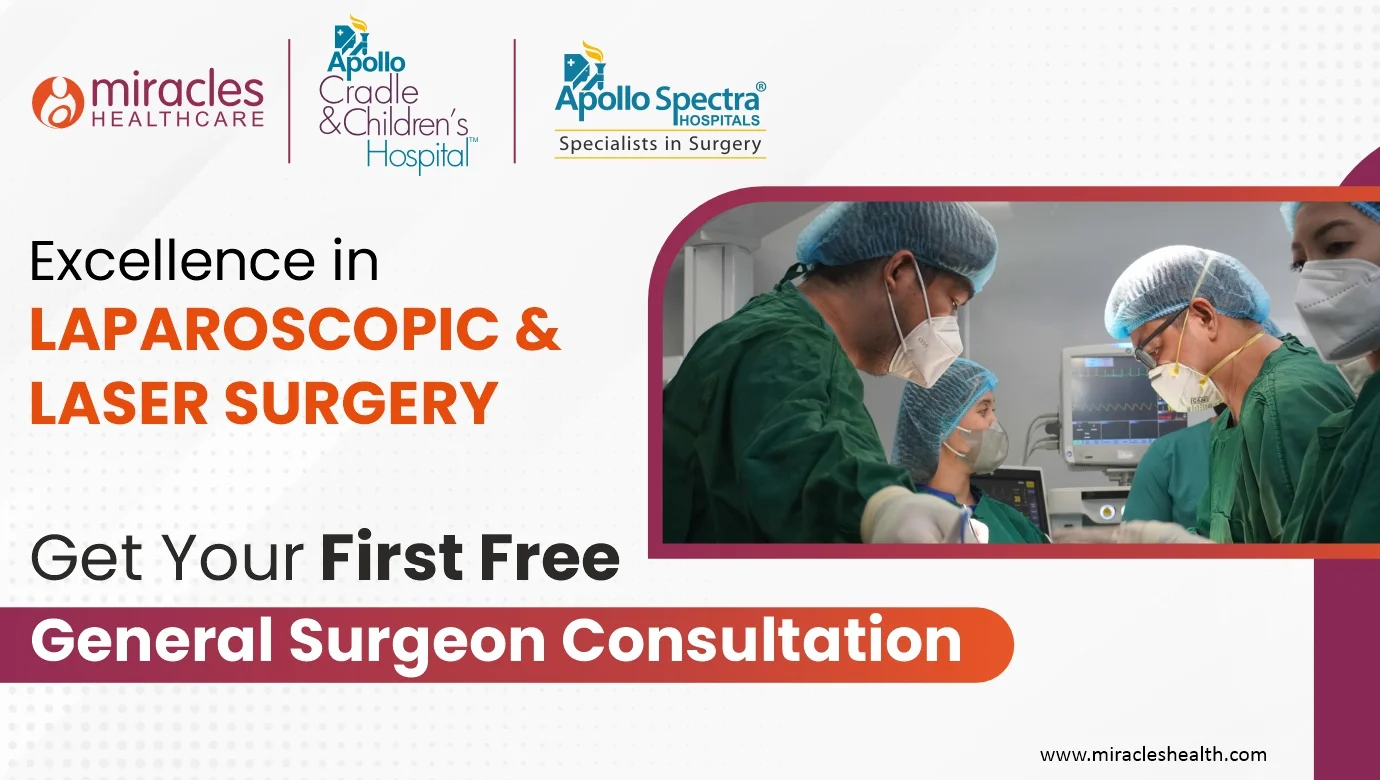General Surgery Conditions We Treat
Comprehensive Care for Your Health

Laparoscopy surgery is a type of keyhole surgery, also known as minimally invasive surgery, that involves performing operations in the abdomen through small incisions using a camera and specialized instruments. This surgery offers benefits like reduced pain, smaller scars, faster recovery, and shorter hospital stays compared to traditional open surgery.
Laparoscopic surgery is a modern surgical technique in which operations in the abdomen are performed through small incisions as compared to the larger incisions needed in traditional open surgery. During this surgery, a laparoscope, a thin tube with a camera and light attached to it, is inserted through one of the small incisions. This allows the surgeon to view the inside of the body on a video monitor. Surgical instruments are then inserted through the other small incisions to perform the procedure.
Laparoscopy surgery offers various advantages over traditional open surgery, including smaller incisions, reduced pain and scarring, faster recovery times, and shorter hospital stays. This surgical procedure is commonly used for procedures such as gallbladder removal, appendectomy, hernia repair, and certain types of colon and gynecological surgeries.
Laparoscopic surgeries are performed to treat several health conditions. Here are some common laparoscopic surgeries including:
Laparoscopic cholecystectomy (laparoscopic gallbladder surgery): Removal of the gallbladder for conditions such as gallstones.
Laparoscopic appendectomy: Removal of the appendix for appendicitis.
Laparoscopic hernia operation: Repair of inguinal, umbilical, or incisional hernias.
Laparoscopic hysterectomy: Removal of the uterus for conditions such as fibroids or cancer.
Laparoscopic colectomy: Removal of part or all of the colon for conditions such as colorectal cancer or diverticulitis.
Laparoscopic nephrectomy: Removal of a kidney, often for kidney cancer or living kidney donation.
Laparoscopic oophorectomy: Removal of one or both ovaries for conditions such as ovarian cysts or cancer.
Laparoscopic gastric bypass: Weight loss surgery for obesity.
Laparoscopic splenectomy: Removal of the spleen for conditions such as blood disorders or trauma.
Laparoscopic adrenalectomy: Removal of the adrenal gland for conditions such as tumors.
Diagnostic laparoscopic surgery: A procedure used to view and diagnose conditions affecting the abdominal and pelvic organs, such as endometriosis, pelvic inflammatory disease, or unexplained abdominal pain. It involves inserting a laparoscope to examine the internal structures and may include taking tissue samples for biopsy.
Laparoscopy is performed for various diagnostic and therapeutic purposes across several medical conditions. Here's an overview:
Abdominal Pain: Laparoscopy helps identify the cause of unexplained abdominal pain, such as appendicitis, ovarian cysts, or endometriosis.
Infertility: It aids in diagnosing conditions like blocked fallopian tubes, endometriosis, or pelvic adhesions, which may contribute to infertility.
Gynecological Disorders: Laparoscopy assists in diagnosing and staging conditions like ovarian cysts, fibroids, ectopic pregnancy, and pelvic inflammatory disease (PID).
Cancer: It is used to stage certain cancers, such as ovarian, uterine, or gastrointestinal cancers, by examining the extent of tumor spread within the abdomen.
Chronic Pelvic Pain: Laparoscopy helps identify the source of chronic pelvic pain, including conditions like endometriosis, pelvic adhesions, or pelvic inflammatory disease.
Gallstones: Laparoscopic surgery for gallstones is the standard treatment for symptomatic gallstones, involving the removal of the gallbladder.
Hernias: Laparoscopic hernia repair is performed to treat inguinal, umbilical, or incisional hernias with smaller incisions and faster recovery.
Gastroesophageal Reflux Disease (GERD): A laparoscopic fundoplication is a surgical option for treating severe GERD by reinforcing the lower esophageal sphincter.
Endometriosis: Laparoscopic excision or ablation of endometrial implants helps alleviate symptoms and improve fertility in women with endometriosis.
Appendicitis: Laparoscopic surgery of appendix is a minimally invasive procedure for removing the inflamed appendix in cases of acute appendicitis.
Obesity: Laparoscopic procedures like gastric sleeve or gastric bypass are used in bariatric surgery to promote weight loss and improve obesity-related health conditions.
The suitability of a candidate for laparoscopy surgery depends on different factors, including an individual's overall health and the particular condition being treated.
Specific condition: Laparoscopic surgery is used for treating a wide range of conditions, including gallstones, appendicitis, hernias, ovarian cysts, endometriosis, and certain types of cancer.
Size and location of the problem: The size and location of the problem within the abdomen or pelvis area may affect whether laparoscopic surgery is possible. Depending on their size, location, and complexity, some conditions may be more challenging to manage with laparoscopic techniques.
Overall Good Health: The patient should be in good health without any particular medical conditions that could increase the risks associated with surgery.
Previous surgeries: Candidates with a history of multiple abdominal surgeries or extensive scar tissue may still be eligible for laparoscopic surgery, but the procedure may be more complex and carry slightly higher risks.
The surgeon decides the suitability of laparoscopic surgery for an individual after considering the factors specific to the patient and their condition.
Preparing for laparoscopy surgery involves several steps to ensure the best possible outcome and recovery. Here a general guidelines on how to prepare for your surgery:
Follow preoperative instructions: Your surgeon will provide specific preoperative instructions to prepare for the surgery. This may include guidelines on fasting, medications to stop or continue taking before the procedure, and any necessary preoperative tests.
Understand the procedure: Discuss the surgery with your surgeon and understand what to expect before, during, and after the procedure in detail. Ask any questions you may have about the surgery, risks, and recovery process.
Quit smoking and limit alcohol: If you smoke, ceasing before surgery can improve healing and reduce the risk of complications. Similarly, limiting alcohol consumption in the days leading up to surgery can facilitate optimal recovery.
Maintain a healthy lifestyle: Adopt healthy habits such as eating a balanced diet, staying hydrated, and getting regular exercise in the weeks leading up to surgery.
By following these preparation steps in consultation with your surgeon, you can help ensure a successful laparoscopic surgery and a smooth recovery process.
Laparoscopic surgery is performed using the following steps:
Anesthesia: Before the surgery starts, you will be given anesthesia to ensure you are comfortable and do not feel pain during the procedure. The type of anesthesia used (general or spinal) will depend on the specific surgery and your medical history.
Incisions: Once you are under anesthesia, the surgeon will make several small incisions, typically ranging from 0.5 to 1.5 centimeters in length, in the abdomen. These incisions serve as entry points for the laparoscope and surgical instruments.
Insertion of laparoscope: A laparoscope, which is a thin tube with a camera and light attached to it, is inserted through one of the incisions. The camera captures the images of the inside of the abdomen and sends them to a video monitor in the operating room, allowing the surgeon to view the surgical site.
Surgical instruments: Specialized surgical instruments are inserted through the remaining incisions. These instruments are used to control organs, tissues, and structures within the abdomen and perform the necessary surgical tasks
Procedure: Using the images provided by the laparoscope and guided by the surgeon's expertise, the surgical procedure is performed. The surgeon may use various techniques, such as cutting, suturing, stapling, or cauterizing, to address the specific condition or perform the necessary surgical procedure.
Closure: Once the procedure is completed, all the surgical instruments are removed, and the incisions may be closed with sutures or surgical glue. In some cases, surgeons may use absorbable sutures which eliminates the need for suture removal.
Laparoscopy surgery offers several advantages over traditional open surgery including:
Smaller incisions: Laparoscopic procedures are performed through small incisions, typically ranging from 0.5 to 1.5 centimeters in length, compared to larger incisions required in open surgery. Smaller incisions result in decreased scarring, less tissue trauma, and lower risk of infection.
Reduced pain: The laparoscopic procedures involve less tissue disruption and trauma. So, patients undergoing laparoscopic surgery often experience less postoperative pain compared to those undergoing open surgery.
Quicker recovery: Due to smaller incisions and reduced tissue trauma, the recovery process is typically faster with laparoscopic surgery.
Minimal blood loss: Laparoscopic surgery typically involves less blood loss compared to open surgery, reducing the associated risks and the need for blood transfusions.
Improved cosmetic outcome: The smaller incisions used in laparoscopic surgery result in minimal scarring, leading to a better cosmetic outcome compared to open surgery.
Enhanced visualization: Laparoscopic procedures utilize a laparoscope, a thin tube with a camera and light attached to it, which provides a detailed and high-definition view of the surgical site, allowing surgeons to view internal structures with greater clarity and precision.
Lower risk of complications: With less tissue trauma and smaller incisions, laparoscopic surgery generally carries a lower risk of complications such as wound infections, and bleeding compared to open surgery.
Versatility: Laparoscopic techniques can be applied to a wide range of surgical procedures across different medical specialties, including general surgery, gynecology, urology, and gastrointestinal surgery.
After laparoscopy surgery, you can expect a period of recovery that typically involves the following:
Recovery room: Immediately after the surgery, you will be taken to a recovery area where the healthcare team will monitor your vital signs and ensure that you wake up safely from anesthesia.
Pain management: You may experience mild pain or discomfort at the incision sites or in the abdomen after laparoscopic surgery. Your surgeon will prescribe you pain medication to help manage any discomfort during the recovery period.
Activity restrictions: You may be advised to move around as soon as possible after surgery to prevent blood clots and promote circulation. During the initial period, you will be advised to avoid strenuous activities and heavy weight lifting for some time.
Diet: Your surgeon will give you some dietary instructions to follow during the recovery period to promote healing and prevent complications.
Follow-up appointments: You will need to attend follow-up appointments with your surgeon to remove any sutures or staples, monitor recovery progress, and address any concerns or complications that may arise.
After laparoscopic surgery, to ensure proper healing and minimize the risk of complications, it is important to follow your surgeon's instructions. Here are some general care tips to follow after laparoscopic surgery:
Incision Care: Keep all the incision sites clean and dry as guided by the surgeon. Follow your surgeon's instructions regarding dressing, showering, and bathing. Avoid swimming or soaking until your surgeon advises you the go-ahead.
Pain Management: Take prescribed pain medications and over-the-counter pain relievers as directed by your surgeon to manage any discomfort or pain.
Activity Restrictions: Follow your surgeon's guidelines regarding activity restrictions. You may be instructed to move around to prevent blood clots, promote circulation, and avoid strenuous activities such as heavy lifting, and intense exercise for the specified period.
Diet: Gradually start eating foods as tolerated, starting with clear liquids and advancing to a regular diet as advised by your surgeon. Keep yourself well-hydrated by drinking plenty of fluids.
Avoid Smoking and Alcohol: If you smoke, abstain from smoking during the recovery period, as it can interfere with healing and increase the risk of complications. Limit your alcohol consumption to enhance the healing process as advised by your surgeon.
Follow-up Appointments: Attend all scheduled follow-up appointments with your surgeon to monitor your recovery progress, remove any sutures or staples, and address any concerns or complications that may arise.
Be Vigilant For Signs of Complications: Be watchful for signs of infection, such as redness, swelling, warmth, or drainage at the incision sites, fever, constant pain, nausea, vomiting, or difficulty urinating. If you experience any of the mentioned symptoms, Contact your surgeon immediately
Rest and recovery: It's normal to feel fatigued during the initial recovery period. So, take plenty of rest, avoid overexertion, and allow your body to heal.
By following these care tips and following up with your surgeon, you can support a smooth recovery and optimize your overall healing after laparoscopic surgery.
While laparoscopic surgery is generally considered safe and effective, like any surgical procedure, it carries some risks. The potential risks and complications associated with laparoscopic surgery include:
Infection: There is a risk of developing a surgical site or internal infection after laparoscopic surgery. Although the risk of infection is comparatively less as compared to open surgery still exists. Proper surgical technique, sterile instruments, and postoperative wound care help minimize this risk.
Bleeding: Although laparoscopic procedures typically involve less blood loss compared to open surgery, there is still a risk of bleeding during or after the surgery.
Organ or tissue damage: During laparoscopic surgery, there is a risk of unintentional damage to nearby tissues or organs, such as blood vessels, intestines, bladder, or nerves.
Blood clots: Long-period immobility during and after surgery increases the risk of developing blood clots in the legs or lungs. Measures such as early mobilization, compression stockings, and blood-thinning medications may be used to reduce this risk.
Anesthesia risks: Anesthesia carries its own set of risks, including allergic reactions, respiratory problems, and adverse effects on the cardiovascular system. Anesthesia providers closely monitor patients throughout the procedure to minimize these risks.
Complications related to gas insufflation: In laparoscopic surgery, the abdomen is inflated with carbon dioxide gas to create space for the surgeon to work. Rarely, this gas can cause complications such as shoulder pain, abdominal bloating, or injury to nearby structures.
Conversion to open surgery: In some cases, laparoscopic surgery may need to be converted to an open procedure due to technical difficulties, unexpected findings, or complications. This increases the risk of certain complications associated with open surgery.
Adverse reactions to medications: Some patients may experience adverse reactions or side effects from medications used during surgery or for pain management afterward. It's important to inform your surgeon of any allergies or sensitivities you may have.
Pain and discomfort: While laparoscopic surgery generally results in less postoperative pain compared to open surgery, some patients may still experience discomfort or pain at the incision sites or in the abdomen during the recovery period.
Other complications: Additional complications associated with laparoscopic surgery may include hernias at the incision sites, bowel obstruction, urinary retention, and prolonged recovery.
It's important to discuss potential risks and complications with your healthcare provider before undergoing laparoscopic surgery and to follow their preoperative and postoperative instructions carefully to minimize these risks.
Several factors can affect the cost of laparoscopic surgery:
Type of surgery: The complexity and type of laparoscopic procedure being performed can significantly impact the cost. More complicated surgeries may require additional time, specialized equipment, and expertise, leading to higher costs.
Hospital or surgical facility: The cost of laparoscopic surgery can vary depending on the hospital or surgical facility where the procedure is performed. Factors such as facility fees, overhead costs, and geographical location can influence the overall cost.
Surgeon's fees: The surgeon's fees for performing the laparoscopic surgery are another significant factor affecting the total cost. Surgeon fees may vary based on their level of experience, expertise, and reputation.
Anesthesia fees: Anesthesia services are an essential component of laparoscopic surgeryThe type of anesthesia used (general anesthesia or local anesthesia with sedation) and the duration of anesthesia administration can affect anesthesia fees.
Medical insurance coverage: The extent of coverage provided by your health insurance plan can impact the out-of-pocket costs associated with laparoscopic surgery.
Preoperative testing and consultations: Preoperative tests, consultations with surgeons, and diagnostic imaging studies (such as MRI or CT scans) may be required before laparoscopic surgery, adding to the overall cost.
Complications: Unexpected complications that arise during or after laparoscopic surgery, such as extended hospital stays, blood transfusions, or the need for revision surgery, can increase the overall cost.
Miracles Apollo Cradle/Spectra is renowned as the laparoscopic surgery hospital in Gurgaon. We offer laparoscopic surgery for appendix, hernia, gallbladder, spleen removal, etc. Our team of highly skilled general surgeons, recognized for their expertise in laparoscopic techniques, ensures optimal surgical outcomes. Equipped with state-of-the-art technology, our hospital excels in both medical and surgical procedures, offering patients the best possible care. From advanced imaging systems to cutting-edge surgical instruments, we prioritize innovation and precision in every aspect of patient treatment. If you are considering laparoscopic surgery and looking for the general surgeon near me, contact us and schedule an online appointment.


Comprehensive Care for Your Health
Meet our expert team of General Surgeon where compassionate care meets expertise.
Inspiring Journeys: True Patient Stories
Miracles Apollo Cradle is a leading Maternity Hospital Gurgaon. We strive to give the best care to our patients.






Your Health, Our Network: Comprehensive Care Across Every Facility.
Learn about the world class health care we provide
Expert Advice and Health Tips
Learn about the world class health care we provide
Laparoscopic surgery is generally considered safe when performed by experienced surgeons in appropriate medical facilities.
Laparoscopy is done to diagnose or treat abdominal and pelvic conditions, such as gallstones, appendicitis, hernias, endometriosis, or fibroids.
Recovery from laparoscopy typically takes 1 to 2 weeks, depending on the procedure and individual’s condition.
Laparoscopy is a minimally invasive surgery, not considered major, as it involves small cuts, less pain, and faster recovery compared to open surgery.
Usually, 2 to 4 small stitches are needed, depending on the number of incisions made during the procedure.
The cost of laparoscopy in rupees can vary widely depending on several factors like the type of surgery, hospital or surgical facility, and geographical location.
Laparoscopic surgery leaves small, barely visible scars that fade over time compared to larger scars from open surgery.
Laparoscopic surgery is used to diagnose and treat abdominal and pelvic conditions, such as gallbladder stones, hernia, appendicitis, ovarian cysts, and infertility issues.
Patients may feel mild discomfort or soreness after the procedure, but it is usually well-managed with medication and subsides within a few days.
Miracles Apollo Cradle/Spectra is the best hospital for laparoscopy surgery in Gurgaon, offering advanced laparoscopic procedures performed by experienced surgeons using modern technology for quicker recovery.